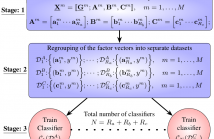
- Read more about Measuring the Task Induced Oscillatory Brain Activity Using Tensor Decomposition
- Log in to post comments
- Categories:
 9 Views
9 Views
- Read more about SPACE ALTERNATING VARIATIONAL ESTIMATION AND KRONECKER STRUCTURED DICTIONARY LEARNING
- Log in to post comments
In this paper, we address the fundamental problem of Sparse
Bayesian Learning (SBL), where the received signal is a high-order
tensor. We furthermore consider the problem of dictionary learning
(DL), where the tensor observations are assumed to be generated
from a Kronecker structured (KS) dictionary matrix multiplied by
the sparse coefficients. Exploiting the tensorial structure results in
a reduction in the number of degrees of freedom in the learning
problem, since the dimensions of each of the factor matrices are significantly
ICASSP19.pdf
- Categories:
 9 Views
9 Views
- Read more about Tensor Ensemble Learning
- Log in to post comments
In big data applications, classical ensemble learning is typically infeasible on the raw input data and dimensionality reduction techniques are necessary. To this end, novel framework that generalises classic flat-view ensemble learning to multidimensional tensor- valued data is introduced. This is achieved by virtue of tensor decompositions, whereby the proposed method, referred to as tensor ensemble learning (TEL), decomposes every input data sample into multiple factors which allows for a flexibility in the choice of multiple learning algorithms in order to improve test performance.
- Categories:
 21 Views
21 Views